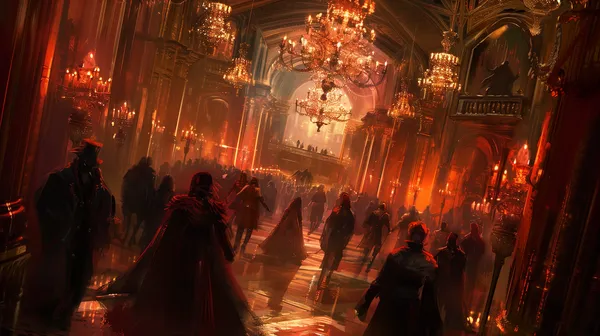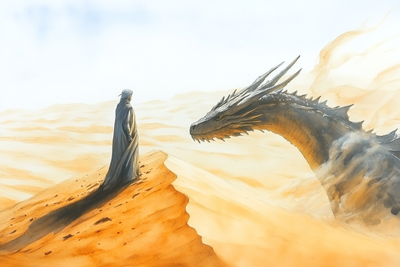This is Part 5 in my series of how I plan roleplay heavy D&D campaigns. For the rest of the posts in this series, click the button and return to the index.
Continuing from my previous post on campaign design, once I have a campaign outline and a full player roster, I start planning individual sessions. I approach nearly all of them the same way—except for Session 1, which I’ll cover in a future post.
For this walkthrough, I’ll use Session 3 of my campaign Shadows Over Siqram as an example.
Where Are We Starting, and Where Are We Going?
Because I run roleplay-heavy games with deep PC integration, I want each session to feel open-ended and player-driven—even though I’m always steering toward a specific beat. My villains keep moving even if the players don’t, but my goal is to crash the PCs into that moving train.
In order to do that, I start with… well the start. For Session 3, the opening scene was:
The PCs are standing in an ancient crypt. They’ve just stopped a deadly ritual. Some unknown priest of some unknown cult was sacrificing townspeople, and the PCs arrived just in time to stop them. Just about all of Session 2 was spent in combat, and at the very end, the PCs recovered a clue - the cultists infernal spellbook.
Additionally, one of the PC’s fiancée was one of the intended sacrifices for the ritual. The PCs managed to save her before the ritual was completed.
There’s a couple of hooks in this scene already - we have the infernal book, we have the fiancée, and we have a bunch of dead cultists who may have some clues on them about what’s going on here. I make note of that, but don’t dwell on it for too long. Then I zoom out: where does the session need to end?
At this point in the campaign, Zakaroth (my BBEG) has completed Steps 1–3 of his plan and is working on Step 4: corrupting a glyph so that, when reinserted into the boundary protecting the city, it destroys it instead. At this point in my planning, I didn’t really have a good end point. So, I went back to the plan and started to interrogate it.
I know why Zakaroth wants to corrupt this glyph. But I hadn’t figured out how he was going to do it. So I looked through my setting and my PCs backstories for inspiration, and I noticed that one of my PCs, Arranis, was an artifact hunter with ties to the black market.
That clicked: what if Zakaroth needed a powerful infernal artifact to use in some infernal ritual to corrupt the glyph? Arranis could be tipped off about it entering the city.
That raised another question: how do you smuggle a magical artifact into a city full of powerful mages and magical defenses? Surely some wizard would notice its magical presence, right?
Answer: Hide it in a crowd.
If the cultists could surround the artifact with so many other magical items that it’s hard to detect any one item, they could slip it in unnoticed. But how?
Again, I went back to my PCs backstories for the answer. Ash had a noble mother—Lady Elithor. We’d seen her briefly in Session 1; the players hated her. She was cold, calculating, powerful, and had a chip on her shoulder about the city failing to investigate her husband’s death.
That was it. Lady Elithor would host a gala. Officially, it’s a fundraiser for the cult’s victims. Secretly, it’s a cover for the smuggling operation. All those wealthy nobles, all those magical items—they provide the perfect magical camouflage.
I wasn't planning on making Lady Elithor a major NPC, but the players hated her so much, I turned her into one of the main villains. This type of player-led story telling is one of my favorite reasons to play TTRPGs!
With that, I had my ending:
The PCs attend Lady Elithor’s gala. They’ll be suspicious that the gala isn’t what it seems, and in the midst of it all, they’ll encounter the smuggling operation. This session ends on a cliffhanger right before the PCs engage with the smugglers.
Before I go off and figure out how the players get there, I need to do a little more work to figure out what else needs to happen in this session.
What needs to move forward?
I keep a “plot tracker” active for all of my campaigns. It’s nothing complicated, just a document that has a list of where each different arc is so that I can make sure I’m pushing them all forward each session. In this campaign I only had 8 sessions to work with, and 4 of them would be mostly combat. That left me with less than 4 sessions to move everything else forward, including player arcs.
At the end of Session 2 when I started planning Session 3, my plot tracker looked like this:
Zakaroth has stolen a glyph (PCs don’t know) and is smuggling an artifact
Arranis is reunited with their fiancée but still doesn’t know why they’re locked out of the Feywild
Izzy has learned that The Raven Queen and Bahamut are intertwined and that Bahamut is missing
Kayson knows her god is struggling to connect with her, and as such some of her cleric powers don’t work.
Ash knows the Marshal of the Guard is dead - he’s in charge now, at least for the time being.
And so, the question I asked myself is “which of these do I want to move forward, and how far do I want them to go?”
I already knew how far Zakaroth’s arc was going to go - I have the end point of the session. For the rest, I just kinda thought through the next logical step:
Arranis is going to learn there is a reason they’re stuck in the Material Plane and can’t get back to the Feywild.
Izzy is going to learn that she’s one of the Raven Queen’s “chosen”
Kayson is going to learn why she’s having a hard time connecting to her god.
Ash is going to learn whether or not he’s getting elected to be the new Marshal
For most of these player arcs, I really didn’t know where they were going - I just kinda thought through “what comes next”. And that’s okay! I really wanted to see how things evolved naturally at the table and then only push the campaign in the direction the players thought would be cool.
At this point, I knew where I was starting, where I was going, and what needed to be pushed forward in this session. The next step for me is to figure out what information I need to give out in order to get there.
What information needs to be delivered?
Before I start designing scenes, I'll take stock of what information I need to deliver. In addition to the information to drive player arcs forward, I also look at what may have happened off screen in the BBEG's plan. For this session, that included Zakaroth stealing corrupted glyph.
Zakaroth’s cultists have managed to weaken the boundary by stealing a glyph!
And then I needed to figure out how to give the information for everything else that needs to move forward this session. To do this, I just work backwards from the “what needs to move forward” bullet points and try to fill in the gap between it and “what do the players know now”. For example, Arranis knew they were stuck in the Material Plane, but they didn’t know why or how. To move Arranis’s arc forward, they needed to find out there’s a reason. So I ask myself, what information do I need to give, and who is going to give it?
To find the answer I looked through my setting, the previous session notes, and player backstories, and decided on two things. The first was that the BBEG knew why Arranis was stuck, and had been planning on using it as leverage to get Arranis to cooperate. The second was that Arranis was part of The Raven Queen’s plans for Siqram. Once I decided on that, I had to decide how to deliver this new information to Arranis. And here’s what I came up with:
Arranis is going to find out that Lady Elithor, working with the BBEG, knows why they’re stuck here. There is a larger scheme going on
Lady Elithor felt like a natural choice, as she was emerging as the hated face of the BBEG. I already knew she was going to throw a gala and that there’d be plenty of opportunity for her and Arranis to interact.
And in that way, I continued on down my list. Here’s what the completed “what information do I need to give” section looked like in my notes:
Lady Elithor is throwing a gala, and the PCs suspect some foul play is happening at it
The cultists have managed to steal a boundary glyph
Lady Elithor is going to tell Arranis that she knows why Arranis is stuck, and how they can get home
The Raven Queen is going to appear to Izzy and inform her she’s a chosen of the Raven Queen
Meilikki (Kayson’s god) will inform Kayson that another god is vying for Kayson’s patronage, that’s why they’ve been disconnected
Ash is going to learn that the Council of Voices is going to vote on whether or not they recommend Ash for the new Marshal of the Guard
I don’t spend a ton of time here, trying to figure out how I’m going to get this information to the players, just what needs to be delivered. This gives me a good grasp of where the session will go, but lets me stay flexible at the table. My players never stick to my plans; they almost always derail them. And I love that! By spending my time in the setting and the goals for the session, I can adapt.
If I anticipate a PC will want to go north and look in the forest for clues, but instead they head east to the swamp, I can on-the-fly figure out how to get the needed information to them in the swamp. If a dryad was going to warn them of some danger in the forest, maybe a will-o-the-wisp is going to do it in the swamp instead.
I could, if needed, stop my session planning here and just improvise the session. It would be a bit bumpy, and wouldn’t flow as well as I want, but I’d feel confident I could get the PCs where I needed them and everyone would have fun.
That said, once I’ve got this list of information I need to deliver, I start to work on thinking through the scenes that would be useful for delivering said information - and that’ll be the topic of the next post.
In the final part of this series I talk through how I plan individual scenes for my players.







